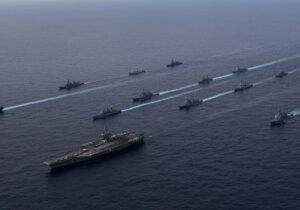The Three-Body Trilogy of novels by China’s leading sci-fi writer Cixin Liu are China’s most popular literary export. But people don’t just read them for the plot: they are also closely examined by Western military analysts.
The Plot Thickens
Liu’s three best-selling titles, The Three-Body Problem (2006), The Dark Forest (2008), and Death’s End (2010), tell the tale of a future Earth’s desperate conflict with a far more advanced alien planet, Trisolaris, the world of the three suns. Events begin during China’s Mao-era Cultural Revolution, where an innocent university professor falls foul of his radicalized students for not being ‘Red’ enough.
As further punishment, the professor’s daughter, Ye Wenjie, is exiled to a rural labor camp. Here, Ye intercepts a radio message from space, warning anyone who receives it never to contact an alien race named the Trisolarans, who destroy any intelligently inhabited planet they find. Embittered by her family’s fate, Ye broadcasts Earth’s coordinates to Trisolaris anyway, as revenge against mankind.
As the dying but powerful planet of Trisolaris is so far away, humanity has centuries to prepare for attack, with Liu detailing the long-term efforts of Earth’s militaries to develop cunning new strategies and weapons to defeat a much more scientifically advanced foe. China will have to do something similar in relation to the US military if it ever wishes to defeat it in some hypothetical future conflict over Taiwan – is Liu’s series just an elaborate metaphor, providing Beijing veiled advice on how to beat Washington?
Liu seems to be a vocal Chinese Communist Party (CCP) loyalist; although perhaps he just doesn’t want to end up in a rural labor camp himself. The qualified engineer turned professional author has been quite happy to address Chinese tech firms on the importance of harnessing “sci-fi thinking” when solving problems for the CCP’s benefit. So, what strategies and weapons has Liu’s own brand of “sci-fi thinking” allowed him to develop on Beijing’s behalf in his own books? Here are just two.
The Hunter Becomes the Hunted: The Dark Forest Hypothesis
Why do the Trisolarans seek to annihilate any inhabited planet they discover? Because they are adherents of game theory, that branch of strategy which ‘games out’ the potential reactions of an opponent, particularly during times of war, tension or economic competition.
The trilogy’s ‘Dark Forest Hypothesis’ imagines the universe as a giant unlit forest, where every planet is an individual hunter creeping through it in silence, with a gun. As soon as he makes a noise and gives away his position, all the other hunters immediately take aim and shoot him dead, not because they wish him any specific ill, but because they have no way of knowing his true intentions. After all, he has a gun, so he might shoot them. It is thus far better to shoot him first.
Translated, this means any planet foolish enough to broadcast its own location via careless radio transmissions must be eliminated as, left alone, it may develop planet-blasting weapons too, like some of its more advanced fellow galactic forest-dwellers will already possess. This explains why the universe seems so silent, devoid of life; any world revealing its own position to others has already committed accidental suicide.
By analogy, Trisolaris could be America, which fears its once-backward rival China/Earth may soon overtake it, so it feels the need to defend itself by completely extinguishing its competitor before this can happen. Imagine if Washington had nuked Moscow during that brief window of opportunity when America had the atom bomb and Russia didn’t.
So, once you have revealed your position of potential future strength to a wider audience – as China has today, with its growing might no longer disguisable – you have no option but to enter the Great Game, there to perish or die. This recalls political scientist Graham T. Allison’s idea of ‘The Thucydides Trap’, in which a declining great power like Sparta/Trisolaris/Washington is bound eventually to spar with a rising one like Athens/Earth/Beijing.
In the book, Earth ultimately engineers a scenario of Mutually Assured Destruction (MAD), whereby if Trisolaris attacks, Earth will broadcast their opponents’ home-world coordinates to even more advanced ETs in the universe, who will quickly blow it up. In real-life Earthling terms, China has instead chosen to massively expand its nuclear arsenal, hoover up US debt and seek control over various key rare minerals, meaning today’s Sparta would be doomed likewise if it did ever dare attack today’s ever-expanding Athens: not that MAD a strategy of self-preservation at all.
KO Computer: Sophons and CIMs
The most interesting Trisolaran weapons are ‘sophons’, eleven-dimensional supercomputers the size of protons, beamed out to arrive on Earth well ahead of the aliens’ actual invasion fleet. Undetectable, they infiltrate the computers of Earth’s leading laboratories, producing false experimental data to prevent mankind from making the technological breakthroughs necessary to develop defensive superweapons.
Today’s China has no literal sophons. However, they do possess more primitive tech potentially allowing them to pursue the exact same strategy of scientific strangulation. They are called CIMs (Cellular Internet Modules), and almost nobody in Western corridors of power knows what they are – apart from Charles Parton, a former UK diplomat in China turned defense analyst. Recently, Parton has gone public in publications like The Spectator and The Times, in apparent despair of politicians taking his fears seriously.
CIMs are present in all modern-day web-enabled tech – which, thanks to the ‘Internet of Things’, no longer means just smartphones and laptops. Essentially, CIMs are the components which allow our devices to connect to the web, facilitating communication, data collection, software updates, etc.
They are not particularly hi-tech, but China is gaining an increasing monopoly on them. Beijing has massively subsidized domestic manufacturers like Quectel and Fibocom to the extent they can sell their components at unrealistically low prices, pushing foreign competitors out of business. Parton points out this may leave the West in a similarly dependent position to that endured by Europe in relation to Russian gas.
Yet, as Parton observes, CIMs have other strategic uses too. China could use them to spy on people. Or they could use CIM-enabled software updates to knock out traffic lights and satellites, or overload electricity-grids via CIM-enabled smart-meters. Or, more subtly, China could use CIM-enabled updates to surreptitiously degrade the performance of Western computers, making our economies and governance less efficient.
Potentially, they could also be used like sophons. Western physics labs obviously use computers too, which will also contain CIMs. Might Beijing already have skewed some of our scientists’ experimental data, without us even knowing? If so, that would certainly be one way for China to erode the present-day technology gap between itself and its enemies.
Chinese Take-Aways
There are many more interpretations these excellent novels can be made to bear. Maybe Cixin Liu is actually a dissident in disguise, and Trisolaris actually represents China, not America (or maybe it keeps swapping around, depending on context). When Earth is warned not to contact Trisolaris, perhaps it is really a coded warning to poor African states not to contact China requesting financial aid which will only facilitate their own ‘debt colonization’ at ruthless Chinese hands; you can invent your meanings where you please.
These days, Liu tends to deny all geopolitical significance to his tale, saying it’s just an exciting story, nothing more. Maybe it is, or maybe this is just another crafty double-bluff. Very possibly the true Chinese game here is to dupe Western military analysts into wasting their time reading harmless sci-fi yarns instead of scrutinizing something more meaningful?
If so, at least they’ll have some fun doing so.






 Sponsor a student for Christianity & National Security 2024
Sponsor a student for Christianity & National Security 2024